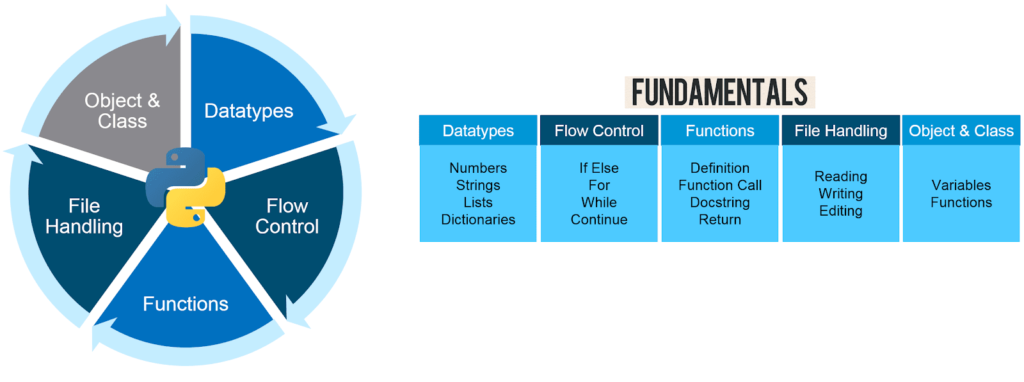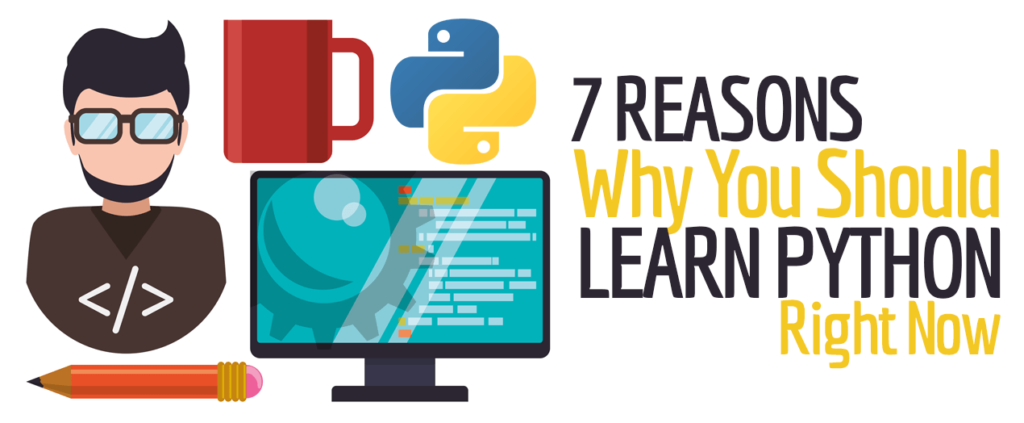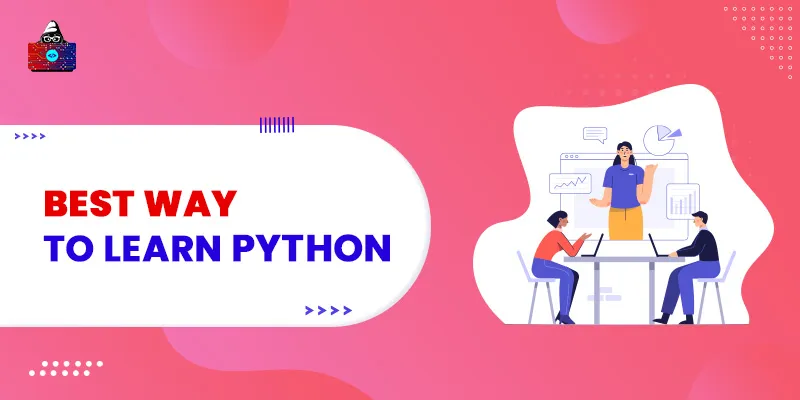If you are a developer and want to grow your programming skills in the modern programming approach, this article is definitely for you. If you have just finished your study and started coding to become a programmer, then this is where you can enhance your skills and add Python to your development career.
Best Way to Learn Python
In this article, we will discuss today's programming world’s most popular and rapidly growing programming language, i.e., when we talk about programming in today's time, Python's name definitely comes.
Developers dominate Python. Python is the leader of the technology world after Java , and this can make you a hero from zero in programming just because of its features. But after these all things, you must be wanted to know what is there in Python which makes it different from all other programming languages and why this is so popular.
So, we will start with the basics of Python and will cover everything about Python’s unique features and how you can learn Python in the best way.
What is Python?
The first question that arises to your mind is obviously what Python is. So, Python is a general-purpose programming language and was first released in 1991. According to Guido van Rossum, the creator of Python, “Python is an interpreted, high-level, object-oriented programming language which has a design philosophy emphasizing code readability, and it often uses English keywords where other programming languages use punctuation.”
Python supports multiple programming paradigms, including functional, procedural, structured, object-oriented, imperative, and a comprehensive standard library. Python’s core philosophy is summarized in the Zen of Python, which says:
- Explicit is better than implicit
- Beautiful is better than ugly
- Simple is better than complex
- The complex is better than complicated
- Readability counts
Python’s syntax is relatively simple and unique than other languages, which can be learned easily. Python is used for server-side Web development, Software development, Automation, Data Science , Machine Learning, System scripting, etc.
The queer thing about Python is that it can handle big data and perform complex mathematics. Python uses duck typing and allows programmers to define their own types using classes. Before version 3.0, there were two classes, i.e., old-style and new-style. In Python 3.0, old classes were eliminated.
Python 3's built-in Types
| Type | Mutable | Description | Syntax example |
| Bool | immutable | Boolean value | True False |
| byte array | mutable | Sequence of bytes | bytearray(b'Some ASCII') bytearray(b"Some ASCII") bytearray([119, 105, 107, 105]) |
| bytes | immutable | Sequence of bytes | b'Some ASCII' b"Some ASCII" bytes([119, 105, 107, 105]) |
| complex | immutable | A complex number with real and imaginary parts | 3+2.7j |
| dict | mutable | An associative array (or dictionary) of key and value pairs; can contain mixed types (keys and values), keys must be a hashable type | {'key1': 1.0, 3: False} |
| ellipsis | An ellipsis placeholder to be used as an index in NumPy arrays | ... | |
| float | immutable | Floating point number, system-defined precision | 3.1415927 |
| frozenset | immutable | Unordered set, contains no duplicates; can contain mixed types, if hashable | frozenset([4.0, 'string', True]) |
| int | immutable | Integer of unlimited magnitude | 42 |
| list | mutable | A list, can contain mixed types | [4.0, 'string', True] |
| set | mutable | Unordered set, contains no duplicates; can contain mixed types, if hashable | {4.0, 'string', True} |
| str | immutable | A character string: the sequence of Unicode codepoints | 'Wikipedia' "Wikipedia" """Spanning multiple lines""" |
| tuple | immutable | Can contain mixed types | (4.0, 'string', True) |
 Example of Python Language
Example of Python Language
Here is a simple program is written in the Python program to calculate the Average of Numbers in a given list.
Code:
n=int(input("Number of elements to be inserted: "))
a=[]
for i in range(0,n):
elem=int(input("Enter element: "))
a.append(elem)
avg=sum(a)/n
print("Average of elements ",round(avg,2))
Output :
Number of elements to be inserted: 5
Enter element: 3, 5, 12, 9, 1
Average of elements 15
Why choose Python over other Languages?

Python works for different platforms such as Windows, Linux, Mac, Raspberry Pi, etc. Python is very simple that allows developers to write programs in fewer lines. Here we summarize the reasons why you should choose Python over other languages: -
-
Simplicity
The simplicity, likeness to English, conciseness, readability, and expressiveness make it the perfect choice for rookies.
-
Open-Source and a Large Community
Python is open-source and has a large community that tries to improve it. A programming community is always beneficial for the availability of many libraries, modules, and packages to help you with your project. Python is ranked by various popular websites, such as the 5th Largest Stack Overflow Community, 4th Most-Used Language at GitHub, and 3rd Largest Meetup Community are some of their examples.
-
Easy to Learn and Code
Python is straightforward to learn and very popular in programming to have a bright career. With Ruby, Python developers are the second-highest-paid professionals after Swift in the programming world. Python is also used in Cyber Security, which is why to learn.
-
Open-Source Frameworks and Libraries
Python is great as a scripting language. Some Python frameworks , such as Django, Pylons, Flask , and Web2py , are used in famous online platforms. Django is used on Instagram and Pinterest. So Python is very popular in web development.
Python frameworks like SciPy and NumPy are used in Artificial Intelligence and Machine Learning. Before Python existed, MATLAB ruled the Artificial Intelligence and Machine Learning world. Still, after Python, it is possible to use a single import statement followed by a function call to perform complex computations.
-
Used with Raspberry Pi
The other interesting part of Python is Raspberry Pi, a microcomputer similar to the size of a credit card. This is used to make robots, remote-controlled toys, arcade machines, and even cameras. You can explore the world of technical DIYs (Do It Yourself) using Raspberry Pi, and with Sonic Pi, you can even make music.
Today Python is everywhere, whether it is for startups or corporates. Python is the perfect combination of flexibility and uniqueness, making it a suitable package for any project. Organizations like Disney, Google, and even NASA always focus on talented Python developers .
These are the several reasons explained. Besides this, the enormous Python community is always available to solve your problem with their strong documentation, tutorials, guides, and examples to help you along the way.
Benefits of Learning Python
There are many languages available in the market for web development, but why and how Python differs from them are remarkable factors. The features which make it popular to use are:
- Python is very easy to code and easier to learn. Its syntax can be learned in just a few hours as the code is quite like English. Python is dynamically typed, which makes it readable.
- One of the outstanding features of Python is its expressiveness. Any program can be written in Python using local transformations, as Python provides countless constructs that help to focus on the solution rather than the syntax.
- Python is open-source and freely available. Anyone can download and install it as its community is headed towards one goal, i.e., an ever-bettering Python.
- Python is the high-level programming language that makes it more developer-friendly.
- Python is a portable language, so writing different code for different machines is unnecessary.
- Python is an object-oriented language. Therefore supports all the features of object-oriented and also supports multiple inheritance, unlike Java.
- Python is an extensible language. You can write in any other language, like C++. Python can be extended to any other language.
- Python code is embeddable. In simple words, you can put your source code written in Python in any other programming language like C++. This feature allows us to integrate the scripting capabilities of other programming languages into our program.
- Python is an interpreted language. There is no need for a compilation of programs in Python. An interpreted language executes code line by line, making debugging the code easier.
- Python supports a large standard library that includes regular expressions, documentation generation, unit testing, web browsers, threading, databases, CGI, email, image manipulation, and a lot of other functionality that can be used to reduce the need to write code for every single thing.
- Python also supports GUI programming by using Tk to create basic GUIs.
- Python is a dynamically-typed language, meaning that the value type is decided at runtime, not in advance.
In summary, Python is:
- Easy to Use
- Expressive, High Level, and Interpreted Language
- Platform Independent
- Open Source
- Object-Oriented language
- Provide huge Standard Library
- GUI Programming
- Integrated
How to Learn Python Quickly?
There are various ways to start learning Python for beginners and advanced learners. If you are a web developer or a Java developer, Python pays off to learn because learning more than one programming language improves your knowledge and experience and enhances your skills. It also increases your chances of being a polyglot programmer, i.e., who knows more than one programming language for companies who value it.
The best way to learn anything is to study and research.
Here are some Tips to Learn Python Quickly:
- Code every day - The very important aspect of any programming language is only practice. A developer committed to coding every day becomes perfect in coding day by day.
- Write it out - Research suggests that notes by hand are most beneficial for long-term retention, especially for those working towards becoming full-time developers.
- Become a Bug Bounty Hunter – When you start writing complex programs, bugs will run into your codes. It happens to all, so don’t let bugs frustrate you. Debugging is a very important part of programming to help you find where things go wrong. Once you have an idea of where things might be breaking down, insert the following line of code into your script and run it: import pdb; pdb.set_trace()
- Take Breaks – When you are learning, no matter as a beginner or advanced learner, it is important to take a break from coding and absorb the concepts. Especially during debugging, if you can’t figure out what’s going wrong, you should take a break.
- Surround yourself with others learning to share the tips and tricks you learn along the way.
- Ask Questions – It’s nice to ask good questions that can help you and others learn and grow. GOOD can be defined as giving context, Outlining things, offering your best guess as to the problem, and demoing what is happening.
- Solve Exercises – For beginners, this is helpful to become confident with Python and be strong with concepts like strings, lists, dictionaries, sets, object-oriented programming, writing classes, etc.
There are lots of online and offline courses available to learn Python. The resources are many; all you need is how much you want to learn.
Best Python Books for Beginners and Advanced Developers
1. Python for you and me
Pym is an online eBook to learn Python, which is all about Python, starting from the basics to programs. This book is targeted at beginners who are completely new to Python.
2. Learn Python the hard way
This book is based on exercises, including 52 various exercises that teach many Python concepts. The book is hard initially, and then you will start enjoying it.
3. A Byte of Python
This is a free eBook for beginners in Python. This book will teach you Python version 3.
4. Head-First Python
The famous book ‘Head First Python’ will enable you to grasp Python's fundamentals quickly, working with the built-in data structures and functions.
Check out: Best Python Books
Conclusion
Python is a popular programming language gaining traction in the current era. It has various applications, including web development, software development, data analysis, data visualization, and task automation. Hence, it opens up a multitude of career opportunities.
The language has become a go-to option among data scientists and other data professionals. This is due to the availability of extensive Python libraries and the language's easy syntax.
In this article, we have helped you on how to learn Python. The only way to master the language is by practicing more and developing Python projects .
People are also reading:




